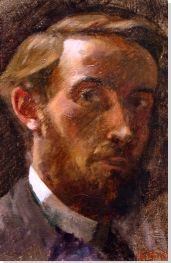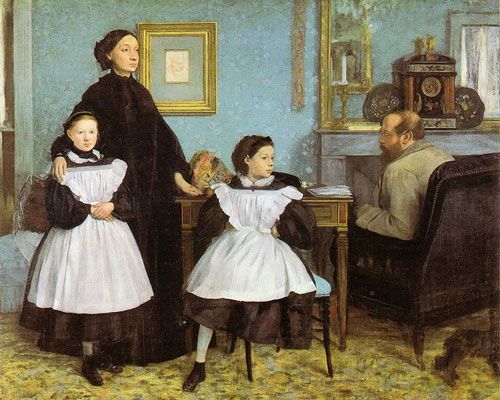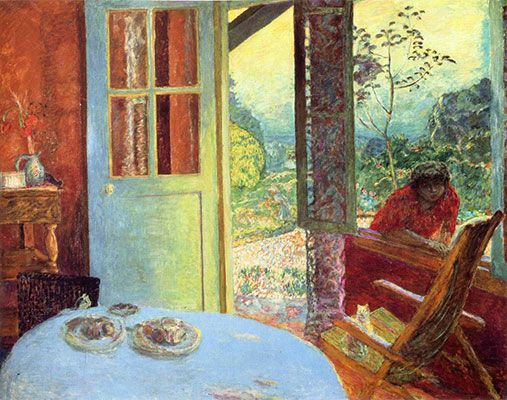Summary of Édouard Vuillard
Édouard Vuillard was a member of the Symbolist group known as Les Nabis (from the Hebrew and Arabic term for "prophets" and, by extension, the artist as the "seer" who reveals the invisible). However, he was less drawn to the mystical aspects of the group and more drawn to fashionable private venues where philosophical discussions about poetry, music, theatre, and the occult occurred. Because of his preference for the painting of interior and domestic scenes, he is often referred to as an "intimist," along with his friend Pierre Bonnard. He executed some of these "intimist" works in small scale, while others were conceived on a much larger scale made for the interiors of the people who commissioned the work.
Accomplishments
- For Vuillard, reticent by nature, the subject of the interior served as a symbol for the interior self, separate from the rest of the world. This is an aspect of a modernist idea - the notion that one's personal viewpoint, a subjective view of reality, can gain insight into the truth.
- As a Symbolist painter and part of the fin-de-siècle escape into the aesthetic, Vuillard employed flat patterns into which his figures were embedded in order to express both emotion and ideas. This kind of abstract painting evolved to communicate ideas not expressible through traditional painterly means. Color and shape could represent experiences that are difficult to express in words.
- Although the Symbolists were, in general, anti-utilitarian (and more art-for-art's sake), Vuillard created large-scale screens and murals that were architectural in conception (and part of the "applied arts"). These large-scale works - intended for the use of interior decoration - linked him to other modernists' search for the "total work of art" (the Gesamtkunstwerk) that would help unify society, but updated it to function in contemporary interior spaces.
Important Art by Édouard Vuillard
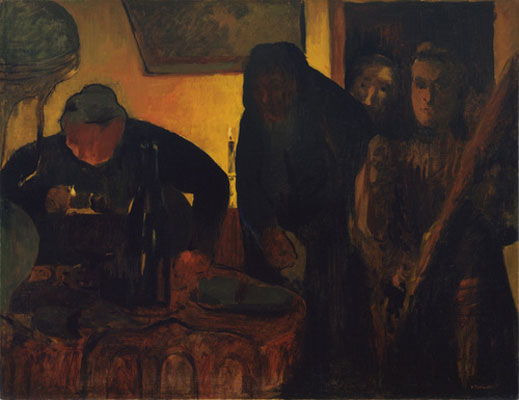
Dinner Time
Vuillard is pictured here with his mother, grandmother, and sister, Marie. In this work the artist contrasts the idea of dinnertime, which is usually a coming together of human solidarity and communication, with the scene pictured here, where each silent family member occupies a separate space, symbolizing their separate inner thoughts. There is bread and wine, but no one is eating or drinking. Madame Vuillard dominates at the left with her massive lateral, and compact silhouette, as she hunches over her task of lighting a flame, her bent elbow and head shrunken down into the neck both shutting out all proximate figures. A highlight of candlelit negative space separates Mme. Vuillard from the grandmother, who likewise shrinks down into herself, her face depicted only with an area of dark shadowing. Marie assumes a frontal stance toward the viewer, but seems to withdraw into a tightened facial expression and magisterially clutching, as if for protection, a sturdy baguette. The artist occupies a separate physical space as he peers from the background through an open doorway. In a subtle bit of irony, typical of Vuillard, a peaceful and idyllic painted landscape leans in toward the scene from above, only serving to underscore the tensions below it. This is a fine example of Vuillard's unique ability to transform cozy domesticity so as to reveal the underlying psychological drama.
Oil on canvas - The Museum of Modern Art, New York
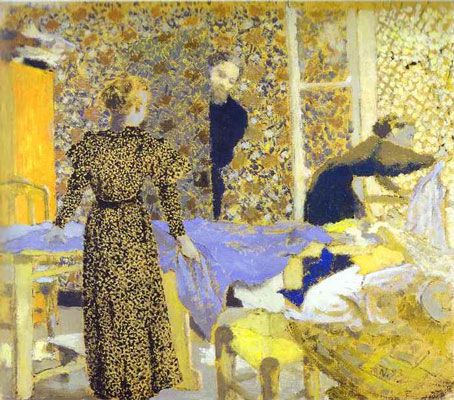
The Suitor
Vuillard painted many pictures of women sewing because his mother (shown at the right) ran a corset-making shop and presumably also worked as a dressmaker, given the presence of so many patterned fabrics in the workspace. It has been pointed out that Vuillard's paintings often show the influence of his familiarity with the theater, as in this work with the figures' postures, gestures, and positioning in space. Sewing - an intense, quiet, and inward activity - is here interrupted by the theatrically timed "entrance" of the centrally placed male figure (Ker-Xavier Roussel, who was to marry Vuillard's sister Marie, shown here gazing toward him as he opens the door).
The figures seem locked into the shapes of their flattened forms or the patterns of their attire and surroundings, particularly the women, who are also depicted with the least individuality. They are symbols of the work they perform: the color and pattern of Marie's dress, for example, is reiterated several times in the blocks of space that surround her. Her patterned dress and surroundings call to mind her everyday work of sewing patterned dresses from patterned bolts of fabric. This work is an example of Vuillard's unique ability to use color and pattern to symbolize states of being such as the repetitiveness of work and/or the loss of individuality through work.
Oil on millboard panel - Smith College Museum of Art, Northhampton, MA
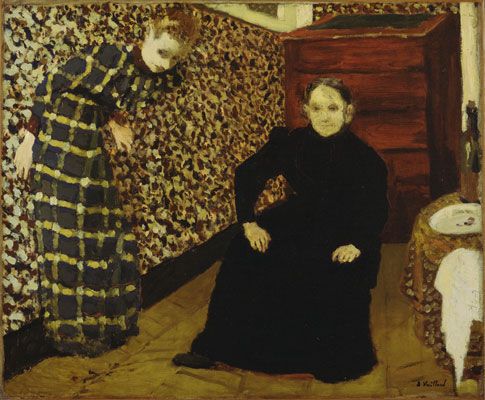
Interior, Mother and Sister of the Artist
This painting depicts Vuillard's sister Marie and his mother Mme. Vuillard. The figures merge and interact with the space. Through pattern, Marie blends into her surroundings; through pattern, the artist is able to suggest that she is what she does. There is a struggle between figure and space, creating an uneasy symbiosis between figure and environment that instills a feeling of psychological disturbance as her form bends to fit the space and suggests ambivalent human relationships. The interior of the space is a burden to Marie, while Mme. Vuillard dominates it.
This work is also an example of the Nabi credo of respecting the overall pattern, the two-dimensional surface, and decorative schema. Although gender and class issues may be subtlety alluded to here, Vuillard's work also alludes to that time of transition when women were entering the workforce. Mme. Vuillard seems perfectly comfortable with, in fact in charge of, her surroundings, while the younger generation, personified by Marie, struggles against the confinement.
This painting of the artist's mother and sister is not an example of portraits in the traditional sense. Here Marie's physiognomy (and posture) is as a puppet/marionette with the upturned and slightly pinched nose and solid black dot of an eye as if a sewn-on piece of felt. This aspect of a puppet, while mildly humorous, can elicit pathos as well. Mme. Vuillard's face, on the other hand, is more like a mask atop a stalwart black silhouette - both entrenched and immovable. Because he is able to generalize, Vuillard's portraits are amongst his most communicative means, and are all the more psychologically intense. In Vuillard's work, the facial features - even when they are altered - become the very symbols of all intense feeling. Vuillard has created his own more modern version of a portrait: the artist combines the specific features of the actual person with non-human and generalized features and thus can refer symbolically to all humanity.
Oil on canvas - The Museum of Modern Art, New York

Album
Vuillard received the comission for this large-scale, five-paneled work (approximately 26 x 80 inches) from Thadee and Misia Natanson. The title derives from the album that serves as the focal point in the center of the picture. The painting has a warm, tapestry-like effect, with contemplative and dreamy female figures and floral motifs woven into patterns and subtly adjusted tonal values. Vuillard decided upon the scale of the piece based on Natanson's actual apartment on the rue Saint-Florentin, just off the Place de la Concorde. The apartment served as a meeting place for the various artists, writers, and musicians, including Claude Debussy, Stéphane Mallarmé, and André Gide, who were part of Thadeé Natanson's avant-garde journal La Revue Blanche. The space for which the painting was intended was large and open, while the space of the painting is said to reflect Misia's interest in the English arts and crafts movements. In this work Vuillard reconciled the private and intimate subject and treatment of the theme with a view toward a more public display.
Art historian Karen Kuenzli has described Vuillard's decorative panels as "... a series of oppositions between the individual and the collective, sensation and ornament, private and public spheres ... [that] point to larger dynamics that define 1890s modernism." Advanced artists in the 1890s valued individualistic artistic creation at the same time that they realized that art, if it were to be sustainable, needed to be grounded in collective practices and ideals.
Oil on canvas - The Metropolitan Museum of Art, New York
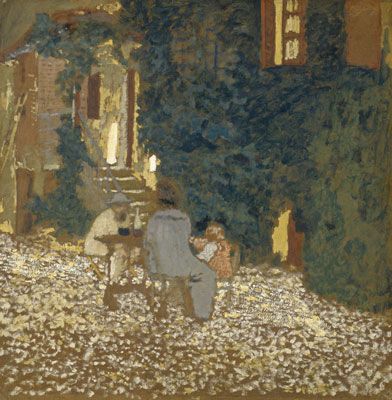
Repast in a Garden
Vuillard painted this work with oil that soaked into the brown cardboard, which was left unpainted in spots, creating an unprecedented degree of flatness. Formally, it shows a great economy of means and a feeling for abstraction in the use of negative space, as the figures become identified with their surroundings. It is also very understated. As in Claude Debussy's opera Péleas et Melisande or the works of the French Symbolist poets and playwrights, there is a tendency to generalize the figures or characters, in which the setting (or the orchestra in the case of the opera) helps to provide the symbolic quality. Symbolist art, music, and literature sought freshness and simplicity, and was bolstered by suggestions and nuances that could imply rather than depict outright. Like the poet Paul Verlaine, Vuillard here paints the "picture" in gray, nuanced half-tones, as if in a minor key. Although figural, it is the style of tightly woven space that creates the content. Vuillard was singular in his ability to use the manipulation of the surface elements to suggest a psychological underpinning to a seemingly idyllic scene.
Oil on cardboard - Washington National Gallery
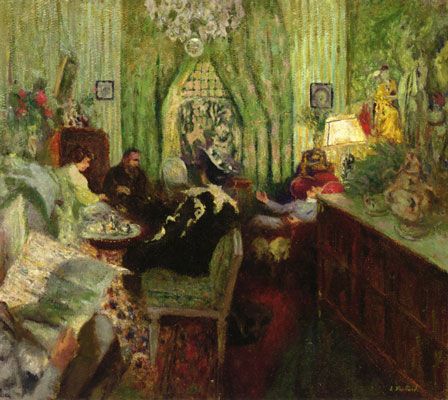
The Salon of Mme. Aron
This painting provides a good example of Vuillard's late work. The subject - a quiet interior with figures - is much the same, and the colors are sumptuous, but the painting features members of the upper class, and is much more conservative in its formal elements. Here we can see his use of time-honored "repoussoir" elements (diagonally-positioned objects like the seated figure reading a newspaper at the left and the dresser at the right that direct and lead the viewer into the picture space). The space of the picture is no longer a flat, patterned surface, but has been inflated once more into a more traditional, three-dimensional box-like space into which the figures and objects are placed. The use of a more traditional space has been linked to Vuillard's increasing use of photographs from which to paint. Vuillard's late work is generally regarded as having less dramatic and psychological impact than his earlier work. Indeed, he stopped exhibiting his work after 1914.
Oil on board - Private Collection
Biography of Édouard Vuillard
Childhood and Education

Jean-Édouard Vuillard, the son of a retired captain, spent his youth at Cuiseaux (Saone-et-Loire), France. But in 1878 his family moved to Paris in modest circumstances. After his father's death in 1884, Vuillard received a scholarship to continue his education. In the Lycée Condorcet, Vuillard met Ker Xavier Roussel (also a future painter and Vuillard's future brother-in-law), Maurice Denis, musician Pierre Hermant, and writer ierre Véber, among others. Vuillard began visiting the Louvre regularly, which influenced his decision to become an artist, but broke with the family tradition of an army career. In 1885, Vuillard left the Lycée Condorcet and joined Roussel at the studio of painter Diogène Maillart. There, Roussel and Vuillard received the rudiments of artistic training. In March 1886, Vuillard embarked upon the fairly rigid curriculum at the Académie Julian where he was taught by Tony Robert-Fleury, and met Pierre Bonnard, with whom he shared a studio.
In July of the following year, on his third attempt, he passed the entrance examination to the École des Beaux-Arts. He was taught by Jean-Léon Gérôme for a brief period of about six weeks in 1888. In 1888, Vuillard began to keep a journal in which he made sketches of works he was studying in the Louvre and noted ideas about future paintings. In these sketches and early works, Vuillard was drawn to the realistic study of still lifes and domestic interiors. He was also attracted to the 17th-century Dutch artists and to the works of Jean-Baptiste-Siméon Chardin. Vuillard kept this private journal from 1888 to 1905 and, later, from 1907 to 1940.
Mature Period
In 1889, Vuillard was persuaded by Denis to join a small group of art students that had formed within the Académie Julian around Paul Sérusier and that referred to itself as the brotherhood of Nabis. Sérusier had communicated to his fellow students his knowledge of Synthetism - a form of Symbolism that relied on memory, imagination, and the use of color and shape to communicate feelings and ideas - following his contact with Paul Gauguin in Brittany. In 1892, on the advice of the Natanson brothers, Vuillard painted his first decorations ("apartment frescoes") for the house of Mademoiselle Desmarais. Subsequently, he fulfilled many other commissions of this kind. With other members of Les Nabis, Vuillard had exhibited small-scale works at the Le Barc de Boutteville Gallery. Later in the 1890s, he showed work through Ambroise Vollard; in 1897, Vollard commissioned him to produce a series of color lithographs on the themes of landscapes and interiors.
Like other Nabi artists, Vuillard was influenced by the simplification and emphasis on expressive contour of 19th-century Japanese woodcuts. The theater was also an important influence on his choice of subjects and muted and mysterious light effects. His closest friend in the theatre was Aurelien Lugne-Poe who, along with Paul Fort's Théâtre d'Art introduced Symbolist drama to Paris. Vuillard not only attended many of the latter's rehearsals and performances of plays by Maurice Maeterlinck, Henrik Ibsen, August Strindberg, and others, but often painted scenery and designed costumes and programs.
Also in the 1890s, Vuillard met and became friendly with the brothers Alexandre and Thadée Natanson, the founders of La Revue Blanche, a cultural review. The editor-in-chief was Thadée Natanson, and he and his wife, Misia (a frequent model during these years), became close friends of Vuillard's. Vuillard's graphics appeared in the journal, together with work by Pierre Bonnard, Henri de Toulouse-Lautrec, Félix Vallotton, and other artists.
Late Years and Death

In the early years of the 20th century, Vuillard began to show work at the Parisian gallery of the Bernheim-Jeune family and was later contracted to them. Lucy Hessel, wife of Joseph Hessel, a partner in the firm, became a close friend, confidante and model, and Vuillard's time was spent increasingly in the Hessels' entourage, which included successful actors and playwrights, as well as wealthy business people.
By the 1910s, Vuillard began to treat his domestic scenes and portraits with a much more palpable sense of depth, and portraiture was an increasingly significant genre in his oeuvre. Vuillard found no shortage of sitters; many were members of fashionable society and/or personal friends or professional colleagues. During World War I, he was called to serve briefly in 1914, as a railway lookout near Paris. He later served as a war artist, sketching soldiers on the front line. However, Vuillard's style and interest in subject matter were, for the most part, not affected by the outbreak of World War I, and the artist continued to concentrate on decorative schemes, though his success would not match his output in the 1890s and the early-20th century. His occasional commissions included four portraits of Roussel, Denis, Bonnard, and Maillol of the Nabis, shown at the Exposition Internationale in Paris in 1937, and a final major mural project for the League of Nations Building, the Palais des Nations, in Geneva.
Vuillard was elected to the highly esteemed Institut de France in 1937, and in 1938, following a major retrospective curated by Vuillard's friend Claude Roger-Marx, he fled occupied Paris.
Notwithstanding the above achievements, Vuillard lived a generally withdrawn life, living with his mother until her death in 1928, and remaining a bachelor throughout. He died in La Baule on June 21, 1940.
The Legacy of Édouard Vuillard
Vuillard's work helped lay the foundation for modernist attitudes toward the arts in believing that a painting could create a parallel reality to the world at large. As a Nabi "prophet" of modern art, Vuillard's achievements as a colorist and as an experimenter in tone have been widely lauded. In addition, his abstract and decorative commissions have been identified in recent scholarship as significant antecedents of twentieth-century modernism, transcending traditional easel painting and moving into the realm of art-as-environment. The artist's large-scale, decorative works that brought painting and architecture together by uniting the flat, abstract picture surface with the two-dimensionality of the wall heralded the major theme of the last 100 years of seeking a more unified and aesthetic world in which to live and of uniting domestic and public arenas. Vuillard's embedding of his figures into a two-dimensional, decorative background also served as a significant precedent for the work of Henri Matisse, who employed similar means.
Influences and Connections

-
![Maurice Denis]() Maurice Denis
Maurice Denis -
![Pierre Bonnard]() Pierre Bonnard
Pierre Bonnard ![Ker-Xavier Roussel]() Ker-Xavier Roussel
Ker-Xavier Roussel
-
![Post-Impressionism]() Post-Impressionism
Post-Impressionism -
![Symbolism]() Symbolism
Symbolism -
![Japonism]() Japonism
Japonism ![Synthetism]() Synthetism
Synthetism
-
![Stéphane Mallarmé]() Stéphane Mallarmé
Stéphane Mallarmé -
![Paul Signac]() Paul Signac
Paul Signac -
![Henri Matisse]() Henri Matisse
Henri Matisse ![Walter Sickert]() Walter Sickert
Walter Sickert
Useful Resources on Édouard Vuillard
- Édouard VuillardOur PickBy Guy Cogeval
- Édouard Vuillard: Catalogue RaisonneOur PickBy Antoine Salomon, Guy Cogeval
- Édouard Vuillard: A Painter and His Muses, 1980-1940By Stephen Brown, Richard R. Brettell
- The Nabis and Intimate ModernismOur PickBy Katherine M. Kuenzli
- The Nabis: Bonnard, Vuillard and Their CircleBy Claire Freches-Thory, Antoine Terrasse
 Ask The Art Story AI
Ask The Art Story AI